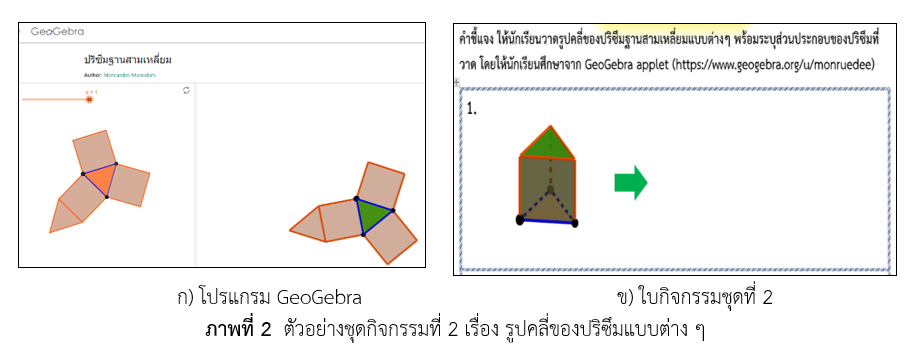การพัฒนาชุดกิจกรรมการเรียนรู้แบบพลวัต GeoGebra เรื่อง ปริซึม เพื่อเพิ่มความคิดเชิงเรขาคณิตสามมิติ
Main Article Content
บทคัดย่อ
งานวิจัยนี้ได้พัฒนาชุดกิจกรรมการเรียนรู้เรื่องปริซึมผ่านสื่อออนไลน์โดยใช้โปรแกรม GeoGebra เพื่อศึกษาความเข้าใจของนักเรียนชั้นมัธยมศึกษาปีที่ 2 ผู้วิจัยได้พัฒนาชุดกิจกรรมขึ้น จำนวน 4 ชุดกิจกรรมประกอบด้วย ชุดที่ 1 เรื่อง การสร้างรูปปริซึมแบบต่าง ๆ ชุดที่ 2 เรื่อง รูปคลี่ของปริซึมแบบต่าง ๆ ชุดที่ 3 เรื่อง พื้นที่ผิวของปริซึมแบบต่าง ๆ และชุดที่ 4 เรื่อง การหาปริมาตรของปริซึมแบบต่าง ๆ ผลจากการศึกษานี้พบว่านักเรียนมีความเข้าใจด้านการแสดงแทนซึ่งสามารถวาดรูปปริซึมและรูปคลี่ของปริซึมแบบต่าง ๆ ได้อย่างดี และส่งเสริมทักษะการให้เหตุผลเพื่ออธิบายระบุส่วนประกอบของปริซึมเพื่อแยกแยะรูปปริซึมได้ อีกทั้งยังเพิ่มทักษะการแก้โจทย์ปัญหาเรื่องพื้นที่ผิวและปริมาตรของปริซึม
Article Details

อนุญาตภายใต้เงื่อนไข Creative Commons Attribution-NonCommercial-NoDerivatives 4.0 International License.
วารสารวิทยาศาสตร์และวิทยาศาสตร์ศึกษา (JSSE) เป็นผู้ถือลิสิทธิ์บทความทุกบทความที่เผยแพร่ใน JSSE นี้ ทั้งนี้ ผู้เขียนจะต้องส่งแบบโอนลิขสิทธิ์บทความฉบับที่มีรายมือชื่อของผู้เขียนหลักหรือผู้ที่ได้รับมอบอำนาจแทนผู้เขียนทุกนให้กับ JSSE ก่อนที่บทความจะมีการเผยแพร่ผ่านเว็บไซต์ของวารสาร
แบบโอนลิขสิทธิ์บทความ (Copyright Transfer Form)
ทางวารสาร JSSE ได้กำหนดให้มีการกรอกแบบโอนลิขสิทธิ์บทความให้ครบถ้วนและส่งมายังกองบรรณาธิการในข้อมูลเสริม (supplementary data) พร้อมกับนิพนธ์ต้นฉบับ (manuscript) ที่ส่งมาขอรับการตีพิมพ์ ทั้งนี้ ผู้เขียนหลัก (corresponding authors) หรือผู้รับมอบอำนาจ (ในฐานะตัวแทนของผู้เขียนทุกคน) สามารถดำเนินการโอนลิขสิทธิ์บทความแทนผู้เขียนทั้งหมดได้ ซึ่งสามารถอัพโหลดไฟล์บทความต้นฉบับ (Manuscript) และไฟล์แบบโอนลิขสิทธิ์บทความ (Copyright Transfer Form) ในเมนู “Upload Submission” ดังนี้
1. อัพโหลดไฟล์บทความต้นฉบับ (Manuscript) ในเมนูย่อย Article Component > Article Text
2. อัพโหลดไฟล์แบบโอนลิขสิทธิ์บทความ (Copyright Transfer Form) ในเมนูย่อย Article Component > Other
ดาวน์โหลด ไฟล์แบบโอนลิขสิทธิ์บทความ (Copyright Transfer Form)
เอกสารอ้างอิง
Alkhateeb, M. A. & Al-Duwairi, A. M. (2019). The effect of using mobile applications (GeoGebra and sketchpad) on the students’achievement. Journal of Mathematics Education, 14(3), 523-533.
Azizul, S. M. J. & Din, R. (2018). Teaching and Learning Mathematics on Geometry Using GeoGebra Software via MOOC. Journal of Personalized Learning, 2(1), 40–51.
Battista, M. (1999). Fifth graders’ enumeration of cubes in 3D arrays: Conceptual progress in an inquiry based classroom. Journal for Research in Mathematics Education, 30(4), 417–448.
Battista, M. (2003). Understanding students’ thinking about area and volume measurement. Reston: National Council of Teachers of Mathematics.
Chehlarova, T. & Chehlarova, K. (2014). Photo-pictures and dynamic software or about the motivation of the art-oriented students. The International Journal for Technology in Mathematics Education, 21(1), 27-31.
Hutkemri, L. & Akmar, S. (2016). Effectiveness of GeoGebra on academic and conceptual knowledge: role of students’ procedural knowledge as a mediator. New Educational Review, 44(2), 153-164.
Jones, K. (2002). Issues in the teaching and learning of geometry. London: Routledge Falmer.
Jones, K., & Mooney, C. (2003). Making space for geometry in primary mathematics. London: Open University Press.
National Council of Teachers of Mathematics (2000). Principles and standards for school mathematics. Reston: Va, NCTM.
López, N. R. (2011). GeoGebra workshop for the initial teacher training in primary education. The International Journal for Technology in Mathematics Education, 18(4), 183-188.
Owens, K. & Outhred, L. (2006). The complexity of learning geometry and measurement. Rotterdam: Sense Publishers.
Pittalis, M., & Christou, C. (2010). Types of reasoning in 3d geometry thinking and their relation with spatial ability. Educational Studies in Mathematics, 75(2), 191-212.
Richardson, S. and Koyunkaya, M. (2017). Fostering students' development of the concept of angles using technology. Australian Primary Mathematics Classroom, 22(1), 13-20.
Zengin, Y. & Tatar, E. (2017). Integrating dynamic mathematics software into cooperative learning environments in mathematics. Journal of Educational Technology & Society, 20(2), 74-88.
Zeynep, A. D. & Abdulkadir, E. (2018). Development of a three dimensional geometric thinking test for early graders. Journal on Mathematics Education, 9(2), 213-226.


